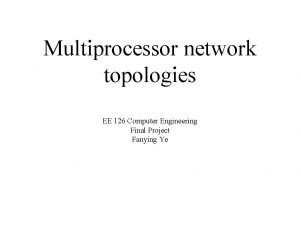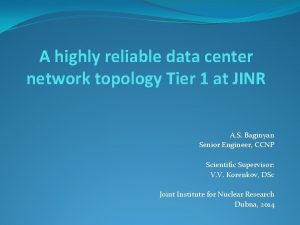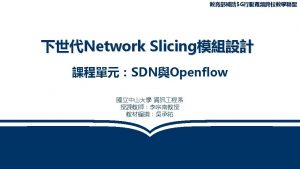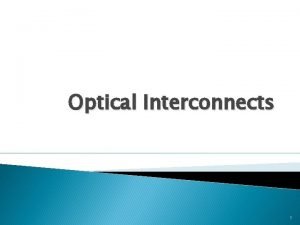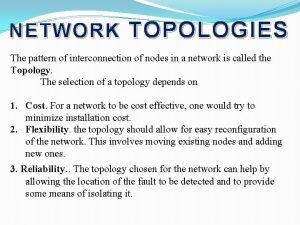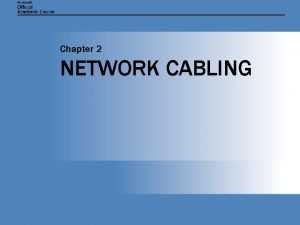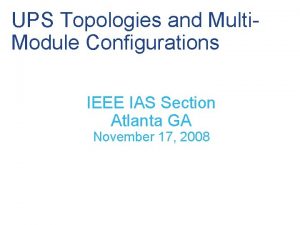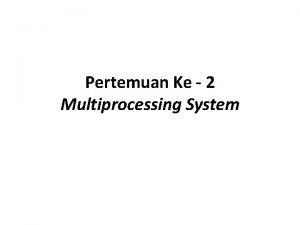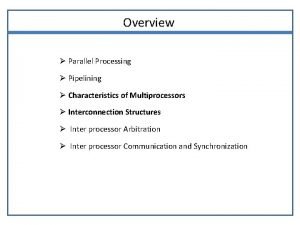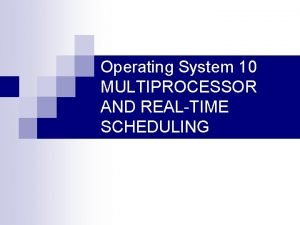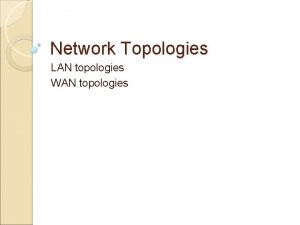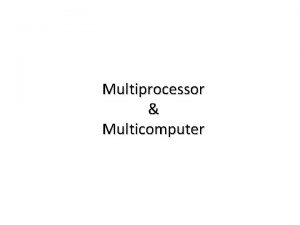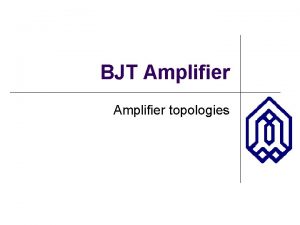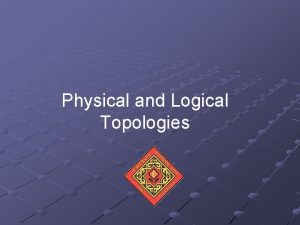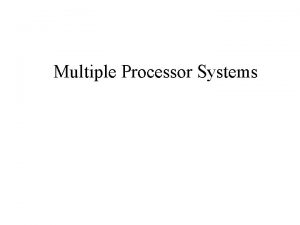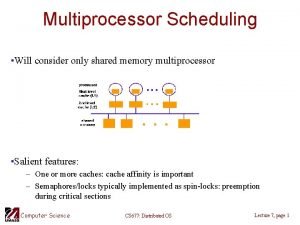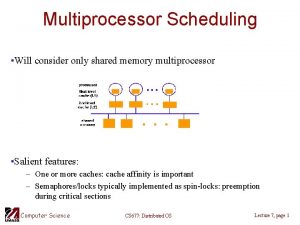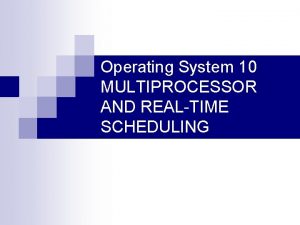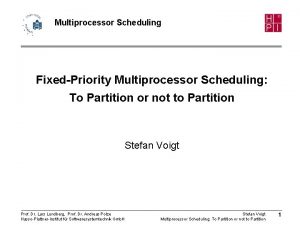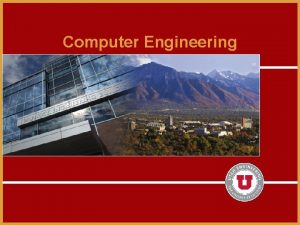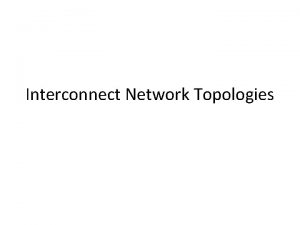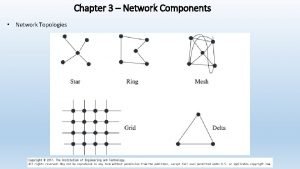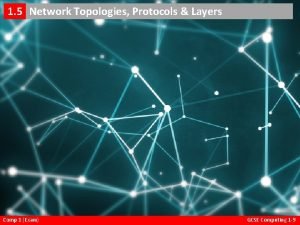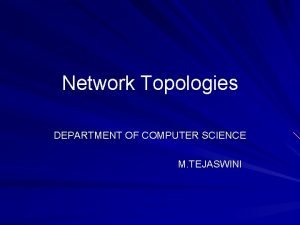Multiprocessor network topologies EE 126 Computer Engineering Final



![Introduction Shared medium arbitrated bus[1] Problems: • Scalability • Communicati on efficiency • Power Introduction Shared medium arbitrated bus[1] Problems: • Scalability • Communicati on efficiency • Power](https://slidetodoc.com/presentation_image_h/0e79c54a0eaade0f07df7328a679b133/image-4.jpg)
![Introduction New concept: Network on chip (No. C)[2] Introduction New concept: Network on chip (No. C)[2]](https://slidetodoc.com/presentation_image_h/0e79c54a0eaade0f07df7328a679b133/image-5.jpg)

















![References [1] Pratim Pande, Cristian Grecu, Michael Jones, Andre Ivanov and Resve Saleh, “Networks References [1] Pratim Pande, Cristian Grecu, Michael Jones, Andre Ivanov and Resve Saleh, “Networks](https://slidetodoc.com/presentation_image_h/0e79c54a0eaade0f07df7328a679b133/image-23.jpg)
- Slides: 23

Multiprocessor network topologies EE 126 Computer Engineering Final Project Fanying Ye

Contents • Introduction • Overview • Comparison of common approaches • The future trends • Conclusions

Introduction Image processing http: //www. kitware. com/blog/files/128_579534278. jpg Weather computation http: //blogs. siam. org/wp-content/uploads/sites/2/2014/01/bunge 2 web. jpg
![Introduction Shared medium arbitrated bus1 Problems Scalability Communicati on efficiency Power Introduction Shared medium arbitrated bus[1] Problems: • Scalability • Communicati on efficiency • Power](https://slidetodoc.com/presentation_image_h/0e79c54a0eaade0f07df7328a679b133/image-4.jpg)
Introduction Shared medium arbitrated bus[1] Problems: • Scalability • Communicati on efficiency • Power consumption
![Introduction New concept Network on chip No C2 Introduction New concept: Network on chip (No. C)[2]](https://slidetodoc.com/presentation_image_h/0e79c54a0eaade0f07df7328a679b133/image-5.jpg)
Introduction New concept: Network on chip (No. C)[2]

Network topology The organization of the shared router nodes and channels in an on-chip network[1]

Principal: Power consumption Area Throughput

Overview Classification

2 D mesh in CLICHE • Most common among all interconnection topologies • It allows incorporation of large number of IP cores in a regular-shape structure [1][2]

Intel’s Teraflops Research Chip Network on a chip – In addition to the compute element, each core contains a 5 -port message passing router. These are connected in a 2 D mesh network that implement message-passing.

2 D torus • The switches at the edges are linked to the switches at the opposite edge through folded channels • The long end-around connections can generate excessive delays [1][3]

2 D folded torus • Excessive delay in torus can be avoided by folding the torus • It renders a more suitable VLSI implementation [1][3]

Octagon • It is designed to overcome the scalability problem as every node can expand into an octagon [1]

Binary Tree • Each router node is linked to 2 nodes in the subsequent level • The main problem : the single parent node especially the root can easily become traffic bottlenecks [3]

Fat tree in SPIN • Fat tree: a node can have more than one parent. This model can alleviate the problem in binary tree. • Every node has four children and the parent is replicated four times at any level of the tree. [1][3]

BFT-Butterfly Fat-Tree • Each router node is linked to either 4 routers or resource nodes. [1][2]

Comparison of Throughput BFT, CLICHE, and Folded Torus provide a lower throughput than do SPIN and Octagon [1]

Comparison of Area Overhead SPIN and Octagon have a considerably higher silicon area overhead. [1]

Comparison of Energy dissipation For uniform traffic For localized traffic SPIN and Octagon have greater average energy dissipation at saturation than the others [1]

Advantages and Disadvantages Advantages SPIN 1. 2. High throughput Good scalability Disadvantages 1. High silicon area overhead 2. Greater average energy dissipation 3. Wiring complexity 2 D-Mesh Simple architecture with good scalability Low throughput 2 D-Torus low power consumption Excessive delay Folded Torus Low power consumption Small delay High silicon area overhead Octagon High throughput 1. High silicon area overhead 2. Greater average energy dissipation BFT Great Localization Wiring complexity

Future trend 3 D-topology • • 3 D-ICs can achieve better performances, more flexibility, and higher throughput. [5] [7] Combining the No. C structure with the benefits of the 3 D integration lead us to present 3 D-No. C as a new architecture. [6] [8]

Conclusion • No. C is an efficient on-chip communication architecture for So. C architectures. Topologies is a key factor in MP-No. C design. • Some architectures can sustain very high data rates at the expense of high-energy dissipation and considerable silicon area overhead, while others can provide a lower data rate and lower energy dissipation levels. • With increasing number of processors in MP-So. C, the 3 D topology will be the next hotspot in research.
![References 1 Pratim Pande Cristian Grecu Michael Jones Andre Ivanov and Resve Saleh Networks References [1] Pratim Pande, Cristian Grecu, Michael Jones, Andre Ivanov and Resve Saleh, “Networks](https://slidetodoc.com/presentation_image_h/0e79c54a0eaade0f07df7328a679b133/image-23.jpg)
References [1] Pratim Pande, Cristian Grecu, Michael Jones, Andre Ivanov and Resve Saleh, “Networks on Chips: A New So. C Paradigm. Performance Evaluation and Design Trade-Offs for Network-on-Chip Interconnect Architectures , ” IEEE TRANSACTIONS ON COMPUTERS, VOL. 54, NO. 8, AUGUST 2005 [2] T. Bjerregaard and S. Mahadevan, “A survey of Research and Practice of Network-on-Chip”, ACM Computing Surveys, Vol. 38, March 2006. [3] Tetala Neel Kamal Reddy, Ayas Kanta Swain, Jayant Kumar Singh and Kamala Kanta Mahapatra, “PERFORMANCE ASSESSMENT OF DIFFERENT NETWORK-ON-CHIP TOPOLOGIES ”, 2014 2 nd International Conference on Devices, Circuits and Systems (ICDCS) [4] http: //download. intel. com/pressroom/kits/Teraflops_Research_Chip_Overview. pdf [5] César Marcon, Ramon Fernandes, Rodrigo Cataldo, Fernando Grando, Thais Webber, Ana Benso, Letícia B. Poehls, “Tiny No. C: A 3 D Mesh Topology with Router Channel Optimization for Area and Latency Minimization”, 2014 27 th International Conference on VLSI Design and 2014 13 th International Conference on Embedded System [6] K. Banerjee, S. J. Souri, P. Kapur, and K. C. Saraswat, “ 3 -D ICs: A Novel Chip Design for Improving Deep-Submicrometer Interconnect Performance and Systems-on-Chip Integration, ” Proceedings of the IEEE, Vol. 89, No. 5, pp. 602 -633, May 2001. [7] Avik Bose, Prasun Ghosal, Saraju P. Mohanty, “A Low Latency Scalable 3 D No. C Using BFT Topology with Table Based Uniform Routing ”, 2014 IEEE Computer Society Annual Symposium on VLSI , pp 136 [8]Y. -L. Jeang et al. “Mesh-Tree Architecture for Network-on-Chip Design”. International Conference on Innovative Computing, Information and Control (ICICIC), pp. 1 -4. 2007.
 Ee 126
Ee 126 5 network topologies
5 network topologies Ppt on network topology free download
Ppt on network topology free download Network security topologies
Network security topologies Highly reliable topology
Highly reliable topology Three-tier network topologies
Three-tier network topologies Network topologies and layout
Network topologies and layout Physical structure of network
Physical structure of network Topology in computer
Topology in computer Three basic network topologies
Three basic network topologies System procurement process in software engineering
System procurement process in software engineering Wlan topology
Wlan topology What is physical topology
What is physical topology Bus network advantages
Bus network advantages Types of topologies of structured cables
Types of topologies of structured cables Ups topologies
Ups topologies Jupiter rising google
Jupiter rising google Shunt series amplifier
Shunt series amplifier Bjt amplifier topologies
Bjt amplifier topologies Bus, ring and star topologies mostly used in the
Bus, ring and star topologies mostly used in the Multiprocessor characteristics
Multiprocessor characteristics Perbedaan antara symmetric dan asymmetric multiprocessing
Perbedaan antara symmetric dan asymmetric multiprocessing Interconnection structure of multiprocessor
Interconnection structure of multiprocessor Real time operating system
Real time operating system
